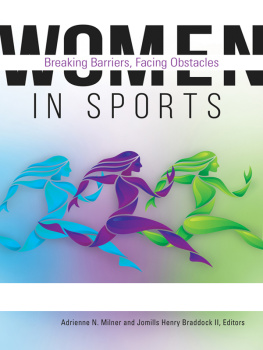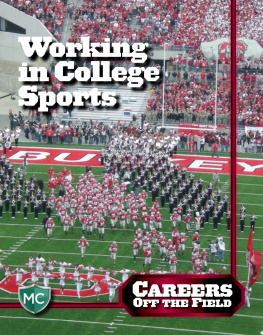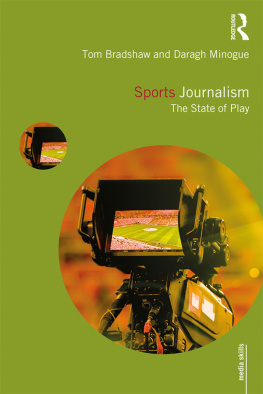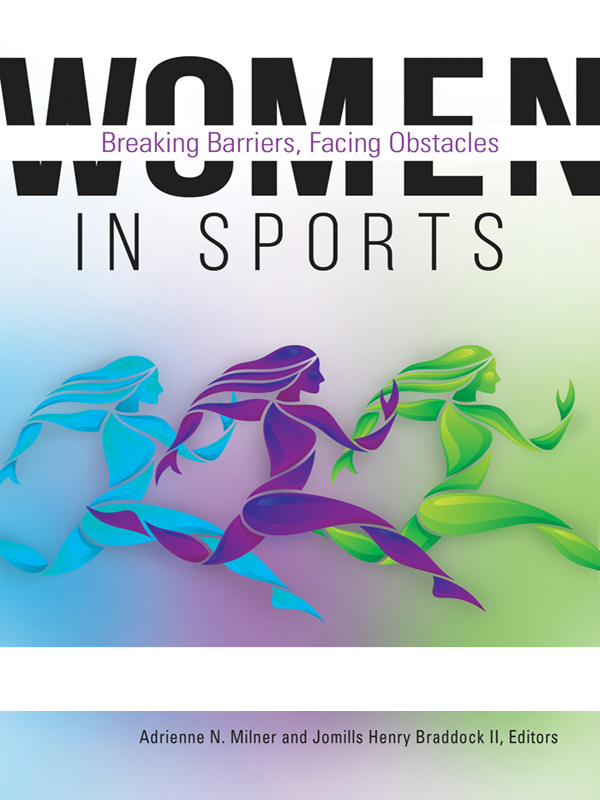Women in Sports
Copyright 2017 by ABC-CLIO, LLC
All rights reserved. No part of this publication may be reproduced, stored in a retrieval system, or transmitted, in any form or by any means, electronic, mechanical, photocopying, recording, or otherwise, except for the inclusion of brief quotations in a review, without prior permission in writing from the publisher.
Library of Congress Cataloging-in-Publication Data
Names: Milner, Adrienne N., editor. | Braddock, Jomills H., editor.
Title: Women in Sports : Breaking Barriers, Facing Obstacles / Adrienne N. Milner and Jomills Henry Braddock II, Editors.
Description: Santa Barbara, California : Praeger, an imprint of ABC-CLIO, LLC, 2017. | Includes bibliographical references and index.
Identifiers: LCCN 2016058150 (print) | LCCN 2017000391 (ebook) | ISBN 9781440851247 (set : alk. paper) | ISBN 9781440851261 (volume 1) | ISBN 9781440851278 (volume 2) | ISBN 9781440851254 (ebook)
Subjects: LCSH: Sports for womenHistory. | Sports for womenSocial aspects. | SportsSex differences. | Sexism in sports. | Women athletesSocial conditions.
Classification: LCC GV709 .W5745 2017 (print) | LCC GV709 (ebook) | DDC 796.082dc23
LC record available at https://lccn.loc.gov/2016058150
ISBN:978-1-4408-5124-7 (set)
978-1-4408-5126-1 (vol. 1)
978-1-4408-5127-8 (vol. 2)
EISBN:978-1-4408-5125-4
21 20 19 18 171 2 3 4 5
This book is also available as an eBook.
Praeger
An Imprint of ABC-CLIO, LLC
ABC-CLIO, LLC
130 Cremona Drive, P.O. Box 1911
Santa Barbara, California 93116-1911
www.abc-clio.com
This book is printed on acid-free paper 
Manufactured in the United States of America
Contents
Andrew J. Young
J. A. Carter
Roxane Coche
Rachel Laws Myers
Scott Norman Brooks
Cheryl MacDonald, Courtney Szto, and Jonathon Robert James Edwards
Kenneth Nathaniel Robinson
Meredith Marie Schertzinger
Diana Tracy Cohen
Helen Owton and Jacquelyn Allen-Collinson
Angie Henderson, Christine Nancy Ingoldsby, and Mark Shuey
Christina Sanchez-Volatier, Jomills Henry Braddock II, Adrienne N. Milner, Ashley Beth Mikulyuk, and Marvin P. Dawkins
While sports have traditionally been viewed as male turf, with their growing participation and significant accomplishments, women have been breaking barriers in sports for decades. Each year women continue to surpass previously held expectations about their athletic capabilities and their potential to achieve greatness in sports. For instance, at the 2016 Rio Olympic Games, Katy Ledecky shattered her own world records to become the woman with the most individual swimming titles ever (four Olympic and seven World Aquatics Championships),
These accomplishments and other instances of women breaking barriers contribute to changing ideology about womens ability and place in sports. For instance, in 2014, Mone Davis became the first African American girl to participate and the first girl to pitch a shutout in the Little League World Series. without Davis to convince viewers that a black woman playing MLB is a realistic premise for a television drama rather than a ridiculous comedy.
Yet despite tangible and ideological progress, today, as in the past, women continue to face both systemic and individual access and treatment challenges as they pursue not only greatness but fairness and full inclusion in sports. Barriers to womens inclusion and equitable treatment in sports have large-scale social, legal, health, and economic consequences. For instance, sex segregation in sports prevents women from receiving financial compensation, media coverage, and decision-making power in athletic contexts on par with that of men. Furthermore, women in sports continue to be subjected to sex testing, critiqued on their physical appearance rather than their athletic performance, and perceived as biologically and athletically inferior to men.
This two-volume collection addresses womens sport involvement in contemporary society with a focus on issues of equity that women currently face. Through empirical and conceptual analyses of womens current experiences in a diverse array of sports rolesfrom recreational through professional levels as athletes, coaches, referees, and administratorsthis collection provides a comprehensive overview of the the state of women in sports. The volumes overarching framework is sociological and examines the state of women in sports by questioning dominant ideology surrounding biological notions of athletic inferiority and interrogates social constructs that affect womens experiences in sports, such as race, socioeconomic status, sexual orientation, nationality, religion, and physical size. However, the contributions in this collection are also multidisciplinary and include research grounded in sociology, psychology, communications, gender studies, education, cultural studies, anthropology, and history to explore the diversity, challenges, and achievements of women in sports. The volumes broad international scope also contextualizes womens experiences in sports within culturally diverse patriarchal societies. In addition, the collection highlights specific areas in need of social change on both the individual and structural levels in order to achieve significant progress toward gender equity and fairness in sports.
VOLUME 1
The first volume of this book focuses on sportswomen and teams. , J. A. Carter frames her own experience as a member of the Cincinnati Sizzle full-contact tackle football team (Womens Football Alliance) within the larger context of womens sports to show how womens participation is often limited through boundaries associated with spatial and material resources, cultural capital, and invisibility.
, Scott Brooks argues that as a dominant black female athlete, Serena Williams is uniquely situated and both pays a price and maximizes her media marketability.
In connection with the marketability of womens sports, using interview data from recent sports competitions, , Kenneth Robinson analyzes the travails associated with the lack of media coverage of womens sports, using the history-making University of Connecticut womens basketball team as a case study.
In addition to sexism in the sports media, , Diana Cohen analyzes interview data from athletes, coaches, race and team directors, and others involved in elite cycling to argue that women in the sport straddle a professionalamateur margin because of governing bodies, sponsors, and media that delegitimize female athletes through sexist rules and allocation of resources.
, Angie Henderson, Christine Ingoldsby, and Mark Shuey use interview data to examine how women on different sports teams at the same university participated in symbolic, horizontal violence, where they acted aggressively toward their peers rather than their oppressors.
The final chapter of the first volume also examines womens participation on different sports teams competing for the same institution. In , Christina Sanchez Volatier et al. use quantitative data to show that gender diversity of U.S. Olympic teams between 1932 and 2012 was positively and significantly associated with success over time.
VOLUME 2
The second volume of this collection focuses on general social trends for women in sports. , Alicia Smith-Tran uses an intersectional approach to examine potential barriers that may prevent black girls and women from becoming recreational runners.










